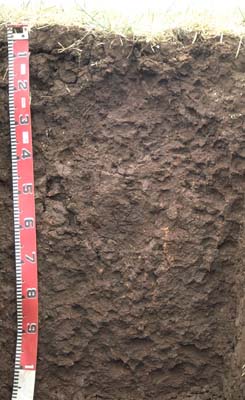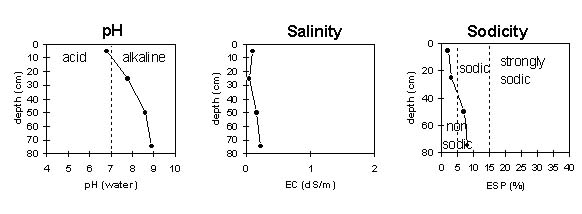Location: Mt Camel
Australian Soil Classification: Endocalcareous, Self-Mulching, Brown VERTOSOL
Great Soil Group: Brown clay
Northcote Factual Key: Ug 5.3
General Landscape Description: Level plain to the east of Mt Camel Range.

LP101 Landscape |
Soil Profile Morphology
Surface Soil
| A1 | 0-10 cm | Dark brown (7.5YR3/4); medium heavy clay; self-mulching and cracking surface condition; strong medium blocky structure; very strong consistence dry; pH 6.8; clear change to: | 
LP101 Profile |
| Subsoil |
| B21 | 10-40 cm | Dark brown (7.5YR3/4); medium heavy clay; moderate coarse blocky structure; very firm consistence dry; pH 7.8; gradual change to: |
| B22 | 40-60 cm | Dark reddish brown (5YR3/4); medium heavy clay; moderate coarse blocky structure; strong consistence dry; pH 8.6; gradual change to: |
| B23 | 60-90 cm | Dark reddish brown (5YR3/4) yellowish red (5YR4/6) mottles; medium heavy clay; moderate coarse blocky, parting to weak medium blocky structure; very firm consistence dry; contains a few (5%) fine-earth carbonates (lime); pH 8.9; gradual change to: |
| B24 | 90 cm+ | Dusky red (2.5YR4/4) and dark red (2.5YR4/6); medium clay; moderate coarse blocky, parting to weak medium blocky structure; very firm consistence dry; contains some pockets of gypsum crystals. |
Key Profile Features:
- High clay content throughout soil profile.
- Vertic properties (i.e. significant shrink-swell characteristic).
- Self-mulching surface soil.
Soil Profile Characteristics:
-
|
pH
|
Salinity
| | |
Surface
(A1 horizon) | Slightly Acid | Very Low | Non-Sodic | None |
Subsoil
(B21 horizon) | Slightly Alkaline | Very Low | Non-Sodic | None1 |
Deeper Subsoil
(at 60-90 cm) | Strongly Alkaline | Low | Sodic | Slight |
1 Slight dispersion after remoulding.

| The surface soil is slightly acid. The upper subsoil is slightly alkaline becoming strongly alkaline with depth. |  | The salinity rating is very low in the surface and upper subsoil and low in the deeper subsoil. |  | The surface and upper subsoil is non-sodic. The subsoil is sodic. |  |  |  |  |
Chemical and Physical Analysis:
Horizon | Horizon Depth
(cm) | pH
(water) | pH
(CaCl2) | EC
dS/m | Exchangeable Cations |
Ca | Mg | K | Na |
meq/100g |
A1 | 0-10 | 6.8 | 6 | 0.1 | 18 | 17 | 1.9 | 0.7 |
B21 | 10-40 | 7.8 | 6.7 | 0.05 | 27 | 22 | 1 | 1.4 |
B22 | 40-60 | 8.6 | 7.7 | 0.16 | 26 | 22 | 0.9 | 3.2 |
B23 | 60-90 | 8.9 | 7.9 | 0.22 | 33 | 27 | 0.9 | 5.1 |
B3 | 90+ |  |  |  |  |  |  |  |
Horizon | Horizon Depth
(cm) | Field
Capacity
pF2.5 | Wilting
Point
pF4.2 | Coarse Sand
(0.2-2.0 mm)
% | Fine Sand
(0.02-0.2 mm)
% | Silt
(0.002-0.02 mm)
% | Clay
(<0.002 mm)
% |
|
|
A1 | 0-10 | 50.4 | 31.2 | 2 | 21 | 17 | 52 |
B21 | 10-40 | 50.6 | 28.9 | 2 | 18 | 15 | 59 |
B22 | 40-60 | 52.2 | 30.6 |  |  |  |  |
B23 | 60-90 | 52.2 | 28.4 |  |  |  |  |
B3 | 90+ |  |  |  |  |  |  |
Management Considerations:
Whole Profile
In general, management strategies for all soils should aim to increase organic matter levels in the surface soil; minimise the degradation of soil aggregates and porosity; promote the development of stable biopores; improve the calcium status of the ion exchange complex (particularly when sodium is a significant part – i.e. sodic), and break up any hardpans. Less frequent tillage; using less aggressive implements, and working the soil at optimum moisture conditions can all assist in maintaining soil aggregation and porosity as well as reducing the breakdown of organic matter. Practices such as residue retention, minimum tillage and including pasture rotations could be utilised if cropping takes place in order to build up organic matter, reduce erosion risk and increase fertility.
Plant available water capacity (PAWC) is considered to be medium to high (estimated at 155 mm). This is based on available laboratory data and assumes an effective rooting depth of 100 cm.
Surface (A) Horizon
The carbon:nitrogen ratio is quite high (22) at this pit site. This indicates that the soil may be poorly nitrified. To better assess this, a bulked sample should be taken across the paddock and analysed for nitrogen. Cracking clay soils such as these tend to mineralise nitrogen readily but total nitrogen levels are rapidly diminished under cropping.
The surface soil is self-mulching which provides a good seed bed that is friable and easily worked.
When the soil is dry, heavy rains will move down soil cracks. This rapid recharge can be valuable for the survival of plants near wilting. When wet, the soil will swell and further infiltration of water will be relatively slow.
The high wilting point value (31%) indicates that plants will be unable to utilise light rains when the soil is relatively dry.
Tillage of cracking clay soils should be avoided if the soil is wet (i.e. wetter than the plastic limit). At such moisture conditions, tillage or excessive trafficking or overstocking could result in structural damage (eg. compaction, smearing) occurring. Ideally, tillage and trafficking should take place on cracking clay soils when the soil is drier than the plastic limit, down to at least the tillage depth.
Subsoil (B) Horizon
There is some evidence of soil compaction in the 10-40 cm layer (i.e. some conchoidal fracturing is evident). Tillage or trafficking of the subsoil should be avoided if the soil is wetter than the plastic limit.
The subsoil displays strong vertic properties (presence of slickensides, significant cracking) which indicates that significant shrinking and swelling occurs with wetting and drying cycles. This may disturb the roots of some plant species and has engineering implications (e.g. disturbance to building foundations and fencelines).
Comments from Landholder:
Pasture/barley/wheat rotation used in last three years.
Superphosphate applied (120 kg/ha).
No nitrogen applied.
Is considered a good cropping soil.
Profile Described By: Mark Imhof, Paul Rampant and Karen DePlater (29/11/95).




